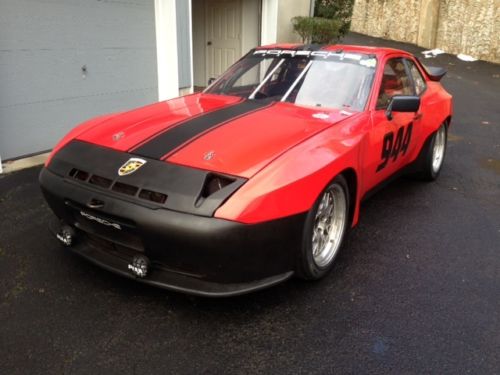For some time, one of the most popular race car trends with Porsche 911s was updating them; for the most part, people would take 1970s and early 1980s 911s and dress then in 964, 993 or in rare cases even the 996. With prices the way that they are on early 911s today, that may seem sacrilegious to many! So it’s not hugely surprising that with the surge in prices of early 911s – in particular, some of the rare racing models – increasingly instead of updating many modifying the venerable track tools have instead started to backdate the cars to earlier looks. Without a doubt, one of the most popular looks in the 911 scene is the RS and RSR models from the early 1970s – a time that really defined the Porsche legend as the defacto street to track weapon. Today’s example is one such backdated car; starting with a 1986 911, the builder selected the early 70s RSR look with IROC body panels. But the transformation of this 80s icon is more than skin deep, as underneath we find a 964-sourced 3.6 flat-6 good for 250 horsepower:
Category: Motorsports Monday
Even though they don’t generally get the big headlines, arguably the Porsche 934 and 935 were the most important car in developing the racing history and reputation of Porsche. While the 356 and early 911s were certainly notable, it was in the mid-1970s with the introduction of turbocharged 911 in 935 form that Porsche developed a sizable following of independents who raced the all-conquering Turbos. In turn, it was these race successes that convinced enthusiasts that the Porsche 930 was THE car to have. The 935 was, in many ways, a development of the earlier 934. Wide flares coupled with wheels and brakes from the prototype category 917 and 936 gave a purposeful and classic look. While the roofline and doors remained effectively the same as the production cars, few other details matched what you could buy at the dealer. One of the biggest developments was the aerodynamic “Slantnose” developed with help from Kremer; it would become the signature look for not only the 935s but also the most expensive versions of the 930 in the 1980s. The 935 also helped breach the gap in between the 917 program and the start of the 956/962; while the 936s were the direct transference between the two, it would be the 935 that would carry the Porsche flag around the world. Amongst the notable wins for the 935 were around 150 international victories including all-out victory at Le Mans in 1979 and multiple wins at both Sebring and Daytona. All of the top-tier racers of the day drove them, and top teams that still race today cut their teeth on the 935, such as todays example run by Reinhold Joest:
CLICK FOR DETAILS: 1978 Porsche 935 Kremer K1 on racecarsdirect
4 CommentsThere’s something that is inherently appealing to me about the idea of a aluminum V8 engine swapped into a Porsche 944. Sure, you could argue that just buying a 928 would scratch that particular itch, and in many ways you’d be right. But say you want extra power and cheaper operating costs? These are things that the Porsche 928 doesn’t particularly excel at, coupled with the more complicated and fragile electronics of the 944’s big brother. The smaller, lighter 944 then seems to be a natural choice; with near perfect weight distribution and bits that swap in easily from the higher-horsepower Turbo model, you can have a track-ready sleeper for about the same price as a decently sorted 928 – but choose the right engine, and you’ll have much more motivation at your call. In the case of this 1987 944, that choice would be the all-aluminum 6.2 liter V8 from the new Corvette – the LS3, rated at 430 horsepower and 424 lb.ft. of torque right out of the box:
CLICK FOR DETAILS: 1987 Porsche 944 LS3 on eBay
3 CommentsIt goes without saying that the Porsche 911 is one of the most popular modified chassis ever conceived, and a fair amount of those modifications are track-based. The results are sometimes mixed; however, one of the more popular trends which I think is pretty slick is backdating 911s. It’s ironic, since for some time it was more popular to update the looks of many of the older race cars to new 964 or 993 bodies. However, the surge in pricing in the 1960s and 1970s 911 market has resulted in many backdated cars coming to market. Obviously, the advantage is that you get a better driving and more powerful car with more options than original, but it’s got the look of the sought after early models. However, probably the biggest advantage is that of price; with a lower entry cost, prospective buyers aren’t afraid to use the 911 where it is well suited; driving fast on a race track. Today I have two different takes on backdated 911s, both with a nod towards the mega-buck RS model. Which is the one you’d choose?
CLICK FOR DETAILS: 1987 Porsche 911 Carrera on eBay
5 CommentsWhile there are a lot of Porsche enthusiasts who love to head to the track, the reality is that few can afford to support the costs of a GT3 Cup car or even Cayman S, as illustrated in my last post. Even a modestly prepared car can be an expensive undertaking. As a result, for some time the biggest bang-for-the-buck has been the Porsche 944. Robust, tunable and naturally well balanced, the cult-classic 944 has taken to many different forms of motorsport; autocross, circuit racing and even the occasional rally. But today, while I’ve got a fairly typical 944 Turbo track build, we also will look at an odd place for the 944 to turn up; the drag strip:




